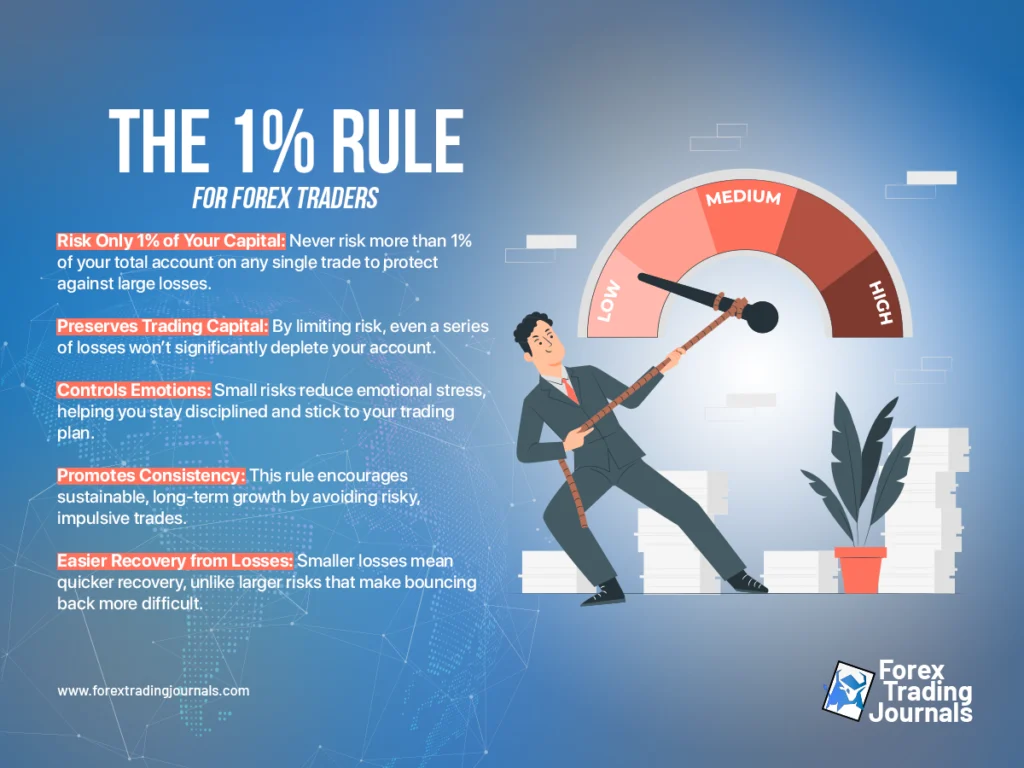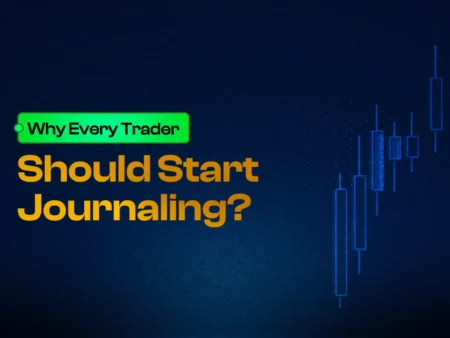Forex trading is often seen as a high-reward investment, but what many beginners fail to realize is that success in forex is built on effective risk management strategies. Without a sound risk management strategy in place, even the best traders can find themselves wiped out by market volatility. Among the most important strategies that experienced traders live by is the “1% rule.”
In this detailed guide, we will dive deep into the 1% rule, explaining how it works and why it’s a game-changer for anyone serious about long-term success in forex trading. We will provide practical examples, show you how to calculate position sizes using this rule, and compare its effectiveness against riskier approaches. By the end of this blog, you’ll understand why small risks can lead to big rewards over time.
What is the 1% Rule?
The 1% rule is a fundamental concept in forex risk management strategies. It states that a trader should never risk more than 1% of their total trading capital on any single trade. This means that regardless of how confident you feel about a particular setup, you should only expose a small fraction of your account to potential losses.

The main reason behind this rule is simple: it protects your trading capital from being swept away by a few bad trades. Even the best traders experience losing streaks, and by limiting your risk per trade, you can weather the storm of market volatility and stay in the game long enough to see profitable trades.
Why the 1% Rule is Essential
The forex market is fast-paced and can be highly unpredictable. Traders who take on too much risk often find themselves in an uncertain situation, where just a few losing trades can severely damage their account balance. On the other hand, traders who adhere to the 1% rule give themselves room to make mistakes and learn without fear of financial ruin.
Here are three main reasons why the 1% rule is essential for success:
- Preservation of Capital: Forex trading isn’t about making a lot of money quickly; it’s about making consistent gains over time. The 1% rule ensures that your capital remains intact even during losing streaks, allowing you to trade another day.
- Emotional Control: Risking only a small portion of your capital per trade helps you stay emotionally detached from the outcome of any individual trade. When you’re not risking a large sum, you can think more rationally and stick to your trading plan, reducing the likelihood of impulsive decisions.
- Compounding Gains Over Time: The 1% rule encourages consistency. While your profits on each trade may seem small, they can add up over time. Coupled with a good trading strategy, you can grow your account gradually without facing major setbacks from a string of losses.
How to Implement the 1% Rule
Implementing the 1% rule in your trading is easy once you understand how to calculate position sizes. Let’s break it down step-by-step:
1. Determine Your Trading Capital
The first step is to figure out how much total capital you have in your trading account. For example, let’s say you have $10,000 in your account. This is your starting point for applying the 1% rule.
2. Calculate 1% of Your Capital
Next, you need to calculate 1% of your total capital. In this case:
- 1% of $10,000 = $100
This means that for any single trade, the maximum amount you are willing to lose is $100. This figure represents your “risk per trade.”
3. Identify the Stop-Loss Level
The next step is to determine where to place your stop-loss order. A stop-loss is a predetermined point at which you’ll exit the trade if the market moves against you. Your stop-loss should be based on technical analysis and market conditions, such as support and resistance levels or volatility.
For instance, if you’re trading a currency pair and decide that your stop-loss will be 50 pips away from your entry point, you’ll use this distance to calculate your position size.
4. Calculate Position Size
Now that you know your risk per trade ($100) and your stop-loss distance (50 pips), you can calculate your position size. Position size refers to the number of lots (or units) you’ll trade.
The formula for calculating position size is:
Position Size = Risk per Trade/(Stop-Loss in Pips × Pip Value)
Let’s assume you’re trading the EUR/USD pair, where 1 pip is worth $10 for a standard lot. Using this formula:
- Risk per trade = $100
- Stop-loss = 50 pips
- Pip value = $10 (for a standard lot)
Position Size = 100/(50×10) = 0.2 lots
This means you should trade 0.2 lots (or 20,000 units) on this particular trade, which ensures that your potential loss is limited to $100 if the market hits your stop-loss.
5. Execute the Trade
Once you’ve calculated your position size, you can execute the trade with confidence, knowing that you’ve followed the 1% rule and minimized your risk.
The Power of the 1% Rule in Action
Let’s compare two traders: one who follows the 1% rule and one who risks a higher percentage of their capital per trade. Both traders start with $10,000 in their accounts.
Scenario 1: Trader A (Following the 1% Rule)
Trader A risks only 1% of their account on each trade. After 10 losing trades in a row, their losses are:
- $100 per trade × 10 trades = $1,000
Trader A’s account balance after 10 losses is $9,000. While these losses aren’t ideal, Trader A still has 90% of their capital left and can recover with profitable trades in the future.
Scenario 2: Trader B (Risking 5% Per Trade)
Trader B, on the other hand, risks 5% of their account on each trade. After 10 losing trades, their losses are:
- $500 per trade × 10 trades = $5,000
Trader B’s account balance after 10 losses is $5,000—half of their initial capital is gone. Recovering from such a large drawdown will be significantly harder for Trader B, as they now need to double their remaining capital just to break even.
The Importance of Drawdown Recovery
One of the reasons the 1% rule is so effective is that it minimizes drawdowns, which are the percentage losses from your peak account balance. Large drawdowns are difficult to recover from because the larger your losses, the harder it is to regain what’s lost.
For example:
- If you lose 10% of your account, you need to make 11% profit to recover.
- If you lose 20%, you need a 25% gain to recover.
- If you lose 50%, you need a 100% gain to break even.
Trader B, in the scenario above, now faces a 50% drawdown, meaning they must achieve a 100% return to get back to their original balance. Trader A, with only a 10% drawdown, needs just an 11% gain to recover.
Benefits of the 1% Rule
Now that we’ve gone through the mechanics, let’s discuss some of the key benefits of the 1% rule and why it’s one of the most valuable forex risk management strategies:
1. Consistency
The 1% rule encourages consistent risk across all trades. This removes the emotional pressure to “make up” for losses by taking larger risks. Consistency in position sizing and risk tolerance is one of the hallmarks of successful traders.
2. Improved Decision-Making
When you know that only a small portion of your account is at risk, it’s easier to stay calm and stick to your trading plan. Emotional trading—such as revenge trading or chasing losses—can quickly spiral out of control. By limiting risk, the 1% rule helps you remain objective.
3. Sustainable Growth
Forex trading is a marathon, not a sprint. The 1% rule allows you to grow your account slowly but steadily. Even if you hit a rough patch, your account won’t be devastated, and you’ll have plenty of capital left to take advantage of profitable opportunities.
4. Adaptability
The beauty of the 1% rule is its adaptability. As your account grows, the dollar amount you risk increases, but the percentage risk remains constant. Conversely, if your account shrinks, the amount you risk decreases, further protecting your remaining capital.
Conclusion: The Big Secret to Long-Term Survival
In the fast-paced world of forex trading, where market conditions can change in an instant, the 1% rule offers a crucial lifeline. By limiting your risk on each trade to just 1% of your capital, you ensure that no single trade—or even a series of losses—can wipe you out.
While the 1% rule might seem overly cautious to some, its value becomes apparent when you consider the long-term game. Trading is not about hitting home runs with every trade but about surviving the inevitable ups and downs and gradually growing your account over time.
Remember, successful forex traders are not defined by their individual wins or losses—they are defined by their discipline, patience, and adherence to solid forex risk management strategies. So the next time you’re tempted to risk more for a quick win, take a step back and remember the 1% rule. Your future self will thank you!





[…] most impactful of all risk management strategies is 1% rule. Risk no more than 1 to 2% of your account on a single trade; this will ensure that you remain […]